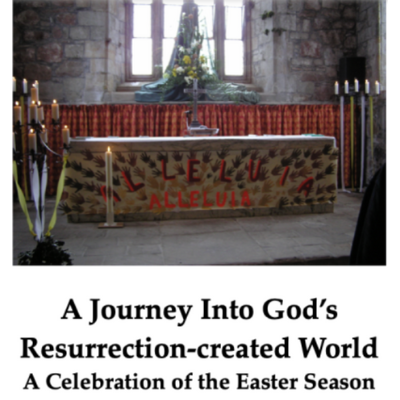guest post by Gary Heard
It’s a nuisance when Easter eggs appear as temperatures reach the 30Cs – having to consume all the chocolate before it melts! ‘Tis a sad waste of a wonderful delicacy to wash it away with soap… Yet this is a minor inconvenience when celebrating Easter away from the emerging spring, so woven into the traditional celebration of Easter inherited from our northern cousins. As Hedley Beare expressed recently (Faith 23/2), fourth-century Christians found it uncannily expedient to attach celebrations of the death and resurrection of Jesus to an earlier pagan festival marking the commencement of spring: themes of new life, rebirth and renewal already irresistibly embodied in the festival, waiting to be impregnated with Christian meaning. The emergence of new life in creation as trees and plants begin regeneration and new growth was a powerful symbol to reflect upon in light of the death and resurrection of Jesus Christ.
But does springtime fully embody the meaning of events surrounding the passion of Jesus? Are we in the Antipodes somehow deprived of a full appreciation of the Easter miracle? Or does this almost exclusive focus on new life mask something more profound about the life and teaching of Jesus?
In Australia Easter comes as trees shed their leaves, and fading light yields to increased darkness. The autumnal equinox marks the shift from days where light is the greater part of the day. Daylight saving’s end creates the impression of a sudden darkness as evening abruptly falls much earlier. The next three months brings days shorter, colder, somehow more alienating. We witness creation in throes of deconstruction: animals begin to hibernate, some birds spread their wings for warmer climes, many flowering plants shut down production, and deciduous trees shed their leaves, ultimately lending a more sober and subdued, even dreary hue to the landscape. While we feel some relief at the passing of scorching heat (although less so this year), there appears little to celebrate, little sign of the new life integral to the Easter story.
The Australian context has yet to find its expression in this Christian celebration. Alongside borrowed Christmas symbols of snow and holly, our Easter celebration strikes a discordant note with the landscape, creation somehow out of sync with the Creator. Either we need to move the celebration of Easter to a more appropriate time of year, or seek themes and messages more consistent with creation’s voice. If an authentic and relevant spirituality reflects and shapes the rhythms of life, how can we ground the Christian message in experiences and symbols common to our setting, as it seems to have been practised by the early church? Is this possible with Easter?
My discomfort with the way Easter – particularly Good Friday – is celebrated in many churches extends beyond its dissonance with the surrounding landscape. Easter within the church reflects society’s broader reluctance to grapple with any sense of pain and loss. Rarely have I sat in a Good Friday service without hearing a strong proclamation of the resurrection: a thought not echoed in the experience of Jesus’ disciples, who were enveloped in despair as they watched Jesus die, the shadow deepened by their complicity in his death through either denial or abandonment in his time of need. In Jesus’ death they saw their hope die. The dream Jesus instilled in them dissipated at the cross.
Yet rarely have I experienced this in a Good Friday service. Jesus’ death seems trivialised against the backdrop of the resurrection, the disciples’ struggle and pain is glossed over, their sense of loss dismissed. Standing on this side of the resurrection makes it difficult to appreciate the emptiness they felt, yet in the journey of faith we must endeavour to enter that same space today.
Contemporary celebrations of Easter often overlook how this new life emerged. An all-pervading gloom marks the Easter story, as critical events occurred under cover of darkness: Jesus’ betrayal, arrest and trial, Peter’s denial; even Jesus’ death took place in darkness. The resurrection hope only emerged through the despairing death of Jesus – the one Christians call the Son of God. Jesus’ disciples, Jews, and Roman authorities clearly could not reconcile the two, as Jesus’ death appeared as conclusive evidence against his claims.
When our primary focus falls on the resurrection without contemplating the circumstances that made it necessary, we merely echo a motivational message that failure is not the end, merely an opportunity to learn and grow. Easter is no tale of persistence through tragedy. But for God raising Jesus from the dead, Jesus’ death was the end. The resurrection was the sole source of light in an otherwise dark tale, and yet an overwhelming source of hope. Jesus’ death flowed from his submission to God’s purposes. In an act of obedience and surrender, Jesus embodied his teaching that the way to life was to lose it, surrendering to the purposes of God. Not seeking to preserve his own life for his own sake, Jesus gave it up for a greater purpose.
Creation at autumn echoes that truth, as flora and fauna ‘die off’ for months, a necessary prelude to new spring growth. Symbols of death surround us: autumn leaves dancing their finale across the streets; lengthening sunsets and cooler evenings driving us into shelter earlier, just as much of the animal world retreats to cosier places; the cries of summer birds slowly silenced; creation slows its pace. As winter dawns, and winter blues cast their shadow, we may despair of ever experiencing summer sun once more. Yet this is part of creation’s rhythm, clearing away the old in preparation for the new. Only as these sights and sounds die can they be born afresh.
New life – springtime – stands now only as promise, just as resurrection was Jesus’ promise to the disciples, just as new life is promise to all who would follow Jesus. Born out of death, resurrected from the demise of the present, new life comes. It is a way to life few choose, preferring to trust in their own strength than to surrender into the hands of another, to hold on rather than let go. To truly live, we must be prepared to die.
Gary Heard is a Baptist Minister and senior lecturer in Pastoral and Ministry Studies in the University of Divinity. He is married to Evelyn and has three adult children.
Photo by Maddi Bazzocco on Unsplash
 It is the Easter Season! Lasting from Easter into Pentecost, it is a time to celebrate and heal! This free download will help you find the joy in the season and includes practical suggestions for celebrating in a Covid-19 world as well.
It is the Easter Season! Lasting from Easter into Pentecost, it is a time to celebrate and heal! This free download will help you find the joy in the season and includes practical suggestions for celebrating in a Covid-19 world as well.

